
iPhone 13 Discontinued
Apple discontinued the iPhone 13 in September 2024 following the introduction of the iPhone 16 lineup. With the launch of the new iPhones, Apple's older models from the iPhone 15 and iPhone 14 models slid down the pricing tiers and the iPhone 13 was removed from the lineup. While Apple is no longer offering the iPhone 13 for sale, it may still be available from third-party vendors. The roundup below is no longer being updated.
Should You Buy the iPhone 13?
The iPhone 13 is Apple's prior-generation iPhone from 2021, and it is two years older than the flagship iPhone 15 models. You'll save $200 choosing the iPhone 13 over the iPhone 15, but it's probably not worth it at this point given the many advances Apple has introduced in the last few years.
Compared to the iPhone 15, the iPhone 13 lacks Emergency SOS via satellite and Crash Detection, two important safety features that are worth upgrading for, plus it has lower battery life, less advanced camera technology, a slower chip, the Dynamic Island, a USB-C port, Ultra Wideband 2, and more.
If you're looking to get a good deal on an iPhone, we track all of the best iPhone sales on iPhone 13, iPhone 14, and iPhone 15 models.
iPhone 13 Features
Contents
Introduced on September 14, 2021, the iPhone 13 has been supplanted iPhone 14 and the iPhone 15 models. Apple is continuing to offer the iPhone 13 as a low-cost device option, priced starting at $599.
The iPhone 13 measures in at 6.1 inches, and it is the same size as the iPhone 14 and iPhone 15. Apple used to offer a 5.4-inch iPhone 13 mini, but it was discontinued when the iPhone 15 models launched in September 2023. The iPhone 13 features flat edges, an aerospace-grade aluminum enclosure, and a glass back. It is available in Pink, Blue, Midnight (black), Starlight (silver/gold), (PRODUCT)RED, and Green.
The iPhone 13 has a Super Retina XDR Display with a 2532x1170 resolution at 460 pixels per inch. It features 1200 nits max brightness for HDR, along with True Tone to match the color temperature of the display to the ambient light, Wide Color for rich, vivid hues, and Haptic Touch for feedback.
The front-facing TrueDepth camera system Face ID notch is smaller than in the iPhone 12, taking up less overall space. Like the current models, the iPhone 13 has a Ceramic Shield cover glass that is infused with nano-ceramic crystals for better protection from drops. IP68 water and dust resistance is included, and the iPhone 13 can hold up to submersion in 6 meters of water for up to 30 minutes.
An A15 Bionic Chip powers the iPhone 13. It features a 6-core CPU with 2 performance cores and 4 efficiency cores, a 4-core GPU, and a 16-core Neural Engine.
There's a diagonal dual-lens rear camera with 12-megapixel Wide and Ultra Wide cameras. The Wide camera features an ƒ/1.6 aperture and Sensor-Shift Stabilization, while the Ultra Wide camera features an ƒ/2.4 aperture. The cameras are not as advanced as the cameras in the iPhone 14 and iPhone 15 models.
Along with the standard Portrait Mode, Night Mode, Time-Lapse and other photographic capabilities, the iPhone 13 includes Cinematic Mode, a feature that uses rack focus to seamlessly shift focus from one subject to another, artfully blurring the background and creating movie-quality depth effects. Cinematic mode shoots in Dolby HDR and the depth of field and blur can be adjusted using the iPhone's camera app. The iPhone 13 also supports 4K video recording at up to 60 fps.
Smart HDR 4 recognizes up to four people in a photo and optimizes contrast, lighting, and skin tones for each one, and Deep Fusion activates in mid to low-light scenes to bring out texture and detail.
Photographic Styles are an upgraded kind of filter that applies selectively to an image, muting colors or boosting vividness without impacting skin tones. There are Vibrant, Rich Contrast, Warm, and Cool options, along with settings for Tone and Warmth for customization and refining.
Apple's iPhone 13 can be unlocked with the Face ID facial recognition system, which works with the 12-megapixel front-facing camera that supports Smart HDR 4, Deep Fusion, Night Mode, Cinematic Mode, Night Mode Selfies, and more.
5G connectivity is included for better quality video streaming, higher-definition FaceTime calls, and improved gaming, but the super fast mmWave speeds are limited to major cities in the United States. Slower sub-6GHz 5G speeds are available in more rural areas in the U.S. and in other countries, and there's support for more 5G bands for 5G connectivity in more places.
The iPhone 13 supports Wi-Fi 6 and Bluetooth 5.0, plus it includes a U1 Ultra Wideband chip for spatial awareness.
Gigabit LTE is offered when 5G isn't available, and to preserve battery life when using 5G, a Smart Data Mode reverts to an LTE connection when 5G speeds aren't necessary. The iPhone 13 has dual eSIM support and doesn't come with a physical SIM by default, but there's still a nano-SIM slot.
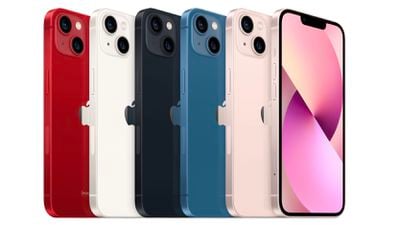
Storage space starts at 128GB and goes up to 512GB at the high end. There's a built-in three-axis gyro, an accelerometer, proximity sensor, ambient light sensor, and barometer.
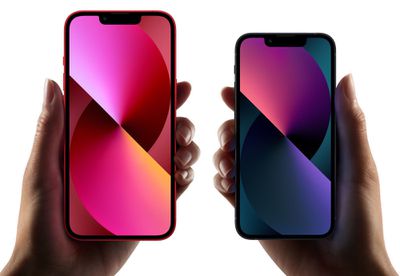
The iPhone 13 has built-in magnets that are compatible with MagSafe accessories, charging at up to 15W with Apple's MagSafe Charger. The iPhone also supports fast charging, which provides 50 percent charge in 30 minutes with a 20W power adapter.
Note: See an error in this roundup or want to offer feedback? Send us an email here.
Pricing and Availability
Pricing on the iPhone 13 starts at $599. The iPhone 13 can be purchased from Apple's online store, Apple retail stores, carriers, and third-party retail stores, and as of 2023, Apple is offering refurbished iPhone 13 models at a discounted price.
Reviews
Reviews of the iPhone 13 at launch in 2021 were largely positive thanks to the improvements in battery life, the faster A15 chip, and the camera updates, but some saw it as merely an iterative update that didn't add enough new features to justify upgrading from an iPhone 12.
The Verge's Dieter Bohn said that battery life is "excellent," pointing to real-world tests.
With regard to the camera, Bohn said that "details are sharp and accurate, colors are rich without being oversaturated, focusing is fast and reliable, portrait mode is good enough to use day to day, and low light and night sight are both exceptional." The Wall Street Journal's Joanna Stern says that while the camera improvements with the iPhone 13 are welcome, they alone are not sufficient enough to convince an iPhone 12 user to upgrade.
CNET said that performance and battery life are solid and that the iPhone 13 would be a reliable option for the majority of people.
For more thoughts on the iPhone 13, see our review roundup or collection of unboxing videos.
Design
With the launch of the iPhone 12, Apple did away with the rounded edges that had been used for iPhones since the iPhone 6, instead adopting a flat-sided design with squared off edges, a look that harkens back to the iPhone 4 and 5 and matches the iPad Pro.
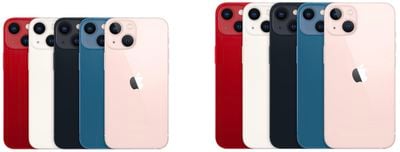
Apple is using that same flat-edged look for the entire iPhone 13, and the device has nearly the same body design as the iPhone 12 models they replaced. There's an all-glass front and a colorful all-glass back that's housed in a color-matched aluminum frame.
There's a notch on the front display of the iPhone 13 that houses the TrueDepth Camera, speaker, and microphone. The notch is smaller than in the iPhone 12, allowing for more overall display area. A set of antenna bands can be found at the top and sides of the phone, along with the power button on the right and volume/silence buttons on the left. Underneath the power button there's a 5G mmWave antenna, but this antenna will only be included on iPhone models sold in the U.S.
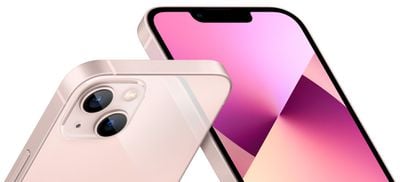
The iPhone 13 has speaker holes and microphones at the bottom, along with a Lightning port for charging purposes. The SIM slot is located on the left side of the device.
A square camera bump is located at the back of the iPhone 13 models, and there's a diagonal lens setup that's a departure from the camera design of the iPhone 12, which featured lenses in a vertical array. According to Apple, the diagonal layout allowed room for new camera technology like sensor-shift optical image stabilization.
Sizes
The iPhone 13 models initially came in 5.4- and 6.1-inch sizes, with the 5.4-inch iPhone 13 mini positioned as Apple's smallest iPhone, but Apple discontinued this model when the iPhone 15 models were released. Apple does not sell a 5.4-inch iPhone anymore.
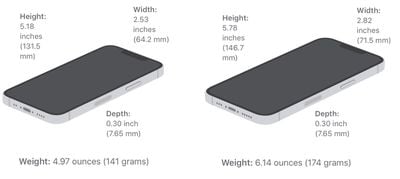
The iPhone 13 is 5.78 inches tall (146.7mm), 2.82 inches wide (71.5mm), and 0.30 inches thick (7.65). It weighs 6.14 ounces (174 grams).
Colors
Apple has been offering its standard iPhone lineup in a range of bright colors for several years now. The iPhone 13 comes in a series of colors that include Starlight (a mixture between silver and gold), Midnight (black), Pink, Blue, (PRODUCT)RED, and Green, a shade that was introduced in March 2022.
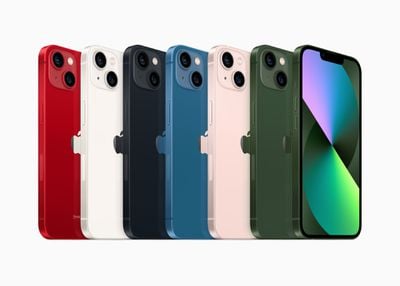
Water Resistance
The iPhone 13 features an IP68 water resistant rating. The smartphone is able to withstand a depth of up to six meters (19.7 feet) for up to 30 minutes, identical to the iPhone 12 models.
In the IP68 number, the 6 refers to dust resistance (and means the iPhone 13 can hold up to dirt, dust, and other particulates), while the 8 pertains to water resistance. IP6x is the highest dust resistance rating that exists. With the IP68 water resistance rating, the iPhone 13 can hold up to splashes, rain, and accidental water exposure, but intentional water exposure should be avoided if possible.
Water and dust resistance are not permanent conditions, according to Apple, and can deteriorate over time as a result of normal wear. Apple's warranty does not cover liquid damage, which means it's best to use caution when it comes to liquid exposure.
Display
The iPhone 13 has an OLED Super Retina XDR display, which is flexible and extends right into the chassis of each device. There's a 2,000,000:1 contrast ratio for blacker blacks and brighter whites, and up to 1200 nits peak brightness for HDR photos, videos, TV shows, and movies. Typical max brightness is 800 nits for the iPhone 13.

The 6.1-inch iPhone 13 features a resolution of 2532 x 1170 with 460 pixels per inch. Wide color support brings vivid, true-to-life colors, and True Tone matches the white balance of the display to the ambient lighting for a paper-like viewing experience that's easier on the eyes. There's also a fingerprint-resistant oleophobic coating and support for Haptic Touch, which provides haptic feedback when interacting with the display.
Notch
While Apple has eliminated the notch on its flagship iPhone lineup, the iPhone 13 continues to have a notch, as does the iPhone 14 that Apple offers as a step up from the iPhone 13. With the iPhone 13, Apple made the notch slightly smaller than the notch that was on the iPhone 12.
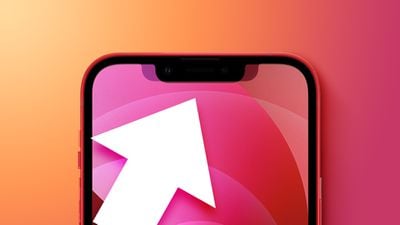
Ceramic Shield
Apple is continuing to use the "Ceramic Shield" material that delivers better drop protection for the iPhone 13. The Ceramic Shield display cover is made by infusing nano-ceramic crystals into glass. The ceramic crystals were manipulated to optimize for clarity while maintaining toughness, with the display created in partnership with Corning.
According to Apple, Ceramic Shield is tougher than any smartphone glass, with a dual-ion exchange process ensuring protection against scratches and everyday wear and tear.
A15 Bionic Chip
The iPhone 13 is equipped with Apple's A15 chip, which has two performance cores and four efficiency cores, along with a 4-core GPU.
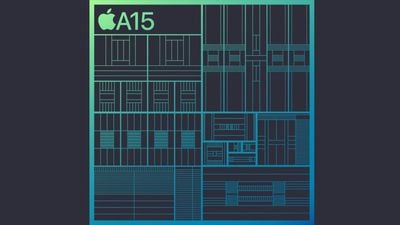
Neural Engine
The 16-core Neural Engine is able to perform up to 15.8 trillion operations per second, and it powers features like Cinematic Mode and Smart HDR 4.
RAM
The iPhone 13 has 4GB RAM, which is 2GB less RAM than the iPhone 14 and iPhone 15. RAM did not change from the iPhone 12 to the iPhone 13.
Storage Space
The iPhone 13 starts with 128GB of storage, and can be ordered with up to 512GB storage space.
TrueDepth Camera and Face ID
For biometric authentication purposes, the iPhone 13 uses Face ID, the facial recognition system that was first introduced in 2017. Face ID components are housed in the TrueDepth camera system in the display notch, which is smaller this year.
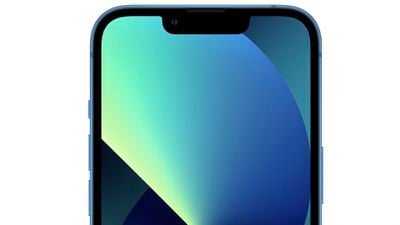
Face ID is used across iOS tasks for unlocking the iPhone, allowing access to third-party passcode-protected apps, confirming app purchases, and authenticating Apple Pay payments.
Face ID works through a set of sensors and cameras. A Dot Projector projects more than 30,000 invisible infrared dots onto the surface of the skin to create a 3D facial scan that maps the curves and planes of each face, with the scan read by an infrared camera.
The facial depth map is relayed to the A15 chip where it is transformed into a mathematical model that the iPhone uses to authenticate identity. Face ID works in low light and in the dark, and with hats, beards, glasses, sunglasses, scarves, and other accessories that partially obscure the face.
Using Face ID With a Mask
When wearing a face mask, users can enable an "Unlock with Apple Watch" feature for convenience. Unlock with Apple Watch allows iPhone users to take advantage of an unlocked and authenticated Apple Watch as an alternative authentication measure to unlock their device when wearing a mask. It can't be used to authenticate Apple Pay or App Store purchases, and it can't unlock apps that require a Face ID scan.

In iOS 15.4, Apple added the ability for Face ID to work with face masks, with no need for an Apple Watch for authentication. Apple says that the feature can "recognize the unique features around the eye" for authentication purposes. If you opt to use this feature during setup, you will need to rescan your face for Face ID. From there, Face ID will be able to unlock your iPhone even when you're wearing a mask.
Apple warns in the Settings app that Face ID is "most accurate" when it's set up for full-face recognition only. For Face ID with a mask to work, you must be looking at your device to get it to unlock, and it does not work when wearing sunglasses. Face ID with a mask can authenticate Apple Pay payments and it can be used in lieu of a login and password in apps that support Face ID, unlike the prior Apple Watch Face ID feature.
- Face ID With a Mask: How It Works and What You Need to Know
- iOS 15.4: How to Set Up Face ID With a Mask
Front-Facing Camera Features
In addition to powering facial recognition, the 12-megapixel ƒ/2.2 camera in the TrueDepth camera system is also a front-facing selfie/FaceTime camera with many of the same features that are available for the rear-facing camera.
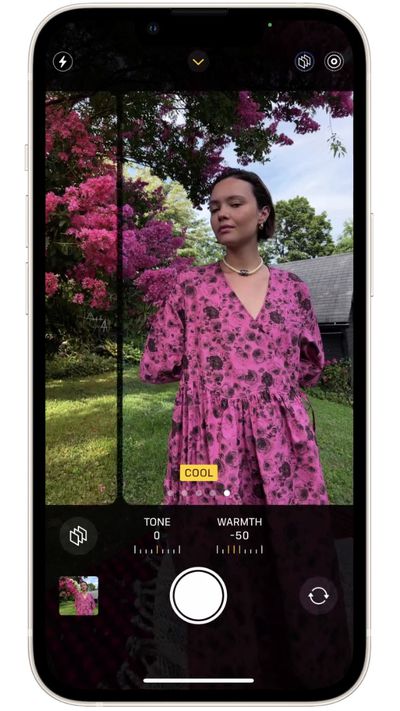
With the A15 chip, the iPhone 13 supports many of the photographic capabilities that are available with the rear cameras, including Night mode for selfies, Smart HDR 4, Dolby Vision HDR recording, and Deep Fusion, along with ProRes and the new Cinematic Mode for capturing videos with movie-like depth of field changes.
4K video recording, QuickTake video, Slo-mo video, Portrait Mode, Portrait Lighting, and the Photographic Styles feature for selectively applying edits are all supported.
Dual-Lens Rear Camera
The iPhone 13 has a diagonal dual-lens camera system. The Wide lens features an ƒ/1.6 aperture, while the Ultra Wide features an ƒ/2.4 aperture. Compared to the iPhone 12, the Ultra Wide camera offers better low light performance, and the updated Wide camera lets in 47 percent more light.
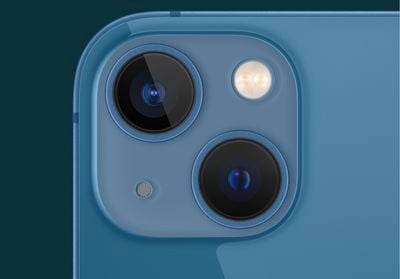
There is no Telephoto lens in the iPhone 13, so it is limited to 2x optical zoom out and digital zoom up to 5x.
Camera Features
- Smart HDR 4 - Recognizes up to four people in a scene and optimizes contrast, lighting, and even skin tones for each person so everyone looks their best.
- Photographic Styles - Photographic Styles are smart, adjustable filters that can do things like boost or mute colors without affecting skin tone. Styles apply selectively to an image, unlike a filter that's applied to the entire image. Photographic Styles include Vibrant (boosts colors), Rich Contrast (darker shadows and deeper colors), Warm (accentuates golden undertones), or Cool (accentuates blue undertones). Tone and Warmth are customizable for each style, so you can get the exact look that you want.
- Night Mode - Takes a series of images over a few seconds and aggregates them together to allow for photography in extreme low lighting situations.
- Deep Fusion - Works in mid to low lighting conditions and brings out the texture and detail in the image.
- Portrait Mode - Keeps the subject of the photo in focus while blurring the background.
- Portrait Lighting - Changes the lighting of Portrait Mode photos with effects that include Natural, Studio, Contour, Stage, Stage Mono, High-Key Mono.
- True Tone flash - True Tone flash is the built-in flash, and it is designed to match the ambient lighting so it doesn't throw off the white balance of the photo when used.
- Panorama - Captures panoramic shots up to 63 megapixels.
- Burst Mode - Allows a series of images to be captured all at once, which is good for high action shots.
Video Recording
The iPhone 13 supports up to 4K video recording at 24, 25, 30, and 60 frames per second, and HDR video recording with Dolby Vision at 4K up to 60 frames per second. 1080p video recording and 720p video recording are also available.
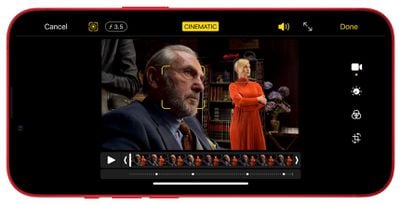
There's a Cinematic Mode that uses rack focus to seamlessly shift the focus from one subject to another when capturing video. It holds focus on the subject while blurring the background, and can automatically change the focus when a new subject is about to enter the scene. Blur and focus can be adjusted after capturing video as well through the Photos app. Cinematic mode works with the Wide, Telephoto, and TrueDepth cameras, and it supports Dolby Vision HDR. Cinematic Mode was improved in iOS 16.
Other video features include QuickTake video, audio zoom, Time-lapse, Night mode Time-lapse, continuous autofocus mode, 3x digital zoom, and the option to take 8-megapixel photos when recording 4K video.
Battery Life
The iPhone 13 is equipped with a 3,227 mAh battery, up from 2,815 mAh in the iPhone 12. It supports fast charging and can charge to 50 percent within 30 minutes using a Lightning to USB-C cable and a 20W power adapter.
5G Connectivity
The iPhone 13 supports 5G networks in addition to LTE networks. The 5G modems in the devices work with both mmWave and Sub-6GHz 5G, which are the two types of 5G, but mmWave speeds continue to be limited to the United States.
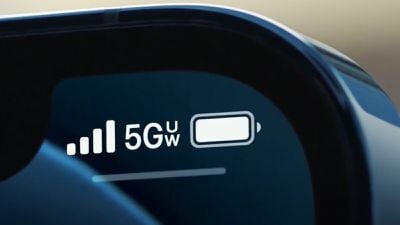
mmWave 5G networks are the fastest 5G networks, but mmWave is short-range and can be obscured by buildings, trees, and other obstacles, so its use is limited to major cities and urban areas along with venues like concerts, airports, and other places where a lot of people congregate.
Sub-6GHz 5G is more widespread and available in urban, suburban, and rural areas across the United States and other countries. For the most part, when you use a 5G network, you'll be using Sub-6GHz 5G. Sub-6GHz 5G is generally faster than LTE, but it's still evolving and it's not the super fast 5G you might be expecting.
5G connectivity allows for faster download and upload speeds, which speeds up everything from loading websites to downloading TV shows and movies. It also increases bandwidth for streaming services so you can watch in a higher resolution, and it brings improved FaceTime call quality. Over 5G or WiFi, FaceTime calls work in 1080p. In areas where LTE speeds are slow because of the sheer number of people, 5G frees up bandwidth and reduces congestion for faster usage speeds.
5G Bands
iPhone 13 in the United States supports over 20 5G bands.
- Sub-6GHz: 5G NR (Bands n1, n2, n3, n5, n7, n8, n12, n20, n25, n28, n29, n30, n38, n40, n41, n48, n66, n71, n77, n78, and n79)
- mmWave: 5G NR mmWave (Bands n258, n260, n261)
LTE Bands
Along with 5G, the iPhone 13 also supports Gigabit LTE with 4x4 MIMO, so you can connect to LTE networks when 5G networks aren't available. The following bands are supported:
- FDD-LTE (Bands 1, 2, 3, 4, 5, 7, 8, 11, 12, 13, 14, 17, 18, 19, 20, 21, 25, 26, 28, 29, 30, 32, 66, 71)
- TD-LTE (Bands 34, 38, 39, 40, 41, 42, 46, 48)
Data Saver Mode
Data Saver Mode is a feature that swaps the iPhone's connection over to LTE when 5G speeds aren't needed in order to preserve battery life.
As an example, when the iPhone is updating in the background, it uses LTE because super fast speeds aren't necessary, but in instances where speed does matter, such as downloading a show, the iPhone 13 models swap over to 5G. There is also a setting to use 5G whenever it's available rather than using the automatic Data Saver Mode.
Dual SIM Support
Dual SIM support allows two phone numbers to be used at one time, enabled through the inclusion of a physical nano-SIM slot and an eSIM. eSIM functionality is available in many countries around the world, and Apple has a list of carriers that support eSIM on its website.
The iPhone 13 was the first iPhone with Dual eSIM support, which means it can use two eSIMs simultaneously rather than just one eSIM and one nano-SIM. iPhone 13 models linked to a carrier will not ship with a physical SIM card this year and carriers will instead use eSIM capabilities for activation.
Bluetooth, Wi-Fi, and U1
The iPhone 13 includes an Apple-designed U1 chip that enables Ultra Wideband technology for improved spatial awareness, allowing the iPhone 13 models to precisely locate other U1-equipped Apple devices. Apple has likened Ultra Wideband to "GPS at the scale of the living room," because the technology is designed for improved indoor positioning and location tracking.
The U1 chip allows the iPhone 13 models to precisely track nearby AirTags. It's also used for directional AirDrop and interaction with the HomePod mini, which also has a U1 chip.
As for Bluetooth and Wi-Fi, the iPhone 13 supports Bluetooth 5.0 and Wi-Fi 6 (802.11ax).
Other Features
Speakers
The iPhone 13 has a stereo speaker at the top where the notch is located and a second stereo speaker at the bottom next to the Lightning port.
Sensors
The iPhone 13 is equipped with a barometer, three-axis gyroscope, accelerometer, proximity sensor, and an ambient light sensor.
GPS and NFC
The iPhone 13 supports for GPS, GLONASS, Galileo, QZSS, and BeiDou location services. NFC with reader mode is included, and there's a background tag feature that allows the iPhone models to scan NFC tags without the need to open an app first.
MagSafe
The iPhone 13 offers built-in MagSafe technology in the form of a magnetic ring that is designed to connect to the MagSafe charger and other magnetic accessories.
The MagSafe charger snaps right onto the back of the iPhone 13 and charges at 15W, which is higher than the 7.5W wireless charging available with Qi-based chargers.
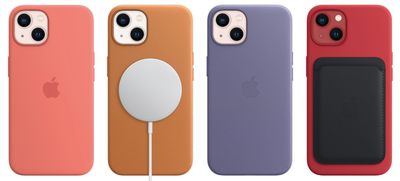
Other magnetic accessories are compatible with the magnetic ring, including cases, sleeves, snap-on wallets, and more, with third-party companies also able to make accessories for the MagSafe iPhones.
Apple warns that MagSafe Chargers can leave a circular imprint on its leather cases, and a similar effect has been seen on silicone cases. Apple also says that credit cards, security badges, passports, and keyfobs should not be placed between the iPhone and MagSafe charger.

